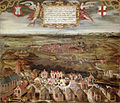Siege of Alkmaar
| Siege of Alkmaar | |||||||
|---|---|---|---|---|---|---|---|
| Part of the Eighty Years' War | |||||||
 The Siege of Alkmaar by Frans Hogenberg | |||||||
| |||||||
| Belligerents | |||||||
|
|
| ||||||
| Commanders and leaders | |||||||
|
|
| ||||||
| Strength | |||||||
| 800 Geuzen, ca.1,300 civilians | 6,500 to 16,000 troops | ||||||
| Casualties and losses | |||||||
| 24+ geuzen, 13 civilians | over 500 | ||||||
The Siege of Alkmaar (1573) was a turning point in the Eighty Years' War. The burghers of the Dutch city of Alkmaar held off the Spanish (who had set up their camp in Oudorp) between August 21 and October 8, 1573, with boiling tar and burning branches from their renewed city walls. On September 23, William the Silent followed up on a request by Cabeliau dating from the beginning of the siege and ordered the dikes surrounding Alkmaar to be breached, thereby flooding the polders in which the Spanish troops were camped. This forced the Spanish commander, Don Fadrique, the son of the hated Alva himself, to retreat and the last Spanish soldiers left on October 8, 1573.[2]
The end of the siege is considered a turning point in the Eighty Years' War as Alkmaar was the first city to overcome a siege by the Spanish army.
The garrison included a detachment of Scots soldiers who had previously tried to defend Haarlem.[3]
A first hand account of the siege exists in the diary of Nanning van Foreest, a local city councillor. Several archaeological examinations have uncovered remains of the battle.[1]
-
A painting showing unfinished fortifications
References
- Citations
- Bibliography
- Nolan, Cathal J. (2006). The Age of Wars of Religion, 1000-1650: An Encyclopedia of Global Warfare and Civilization. Greenwood Publishing Group. ISBN 978-0313330452.
- Knüsel, Christopher; Smith, Martin (2013). The Routledge Handbook of the Bioarchaeology of Human Conflict. Routledge. ISBN 9781134677979.

